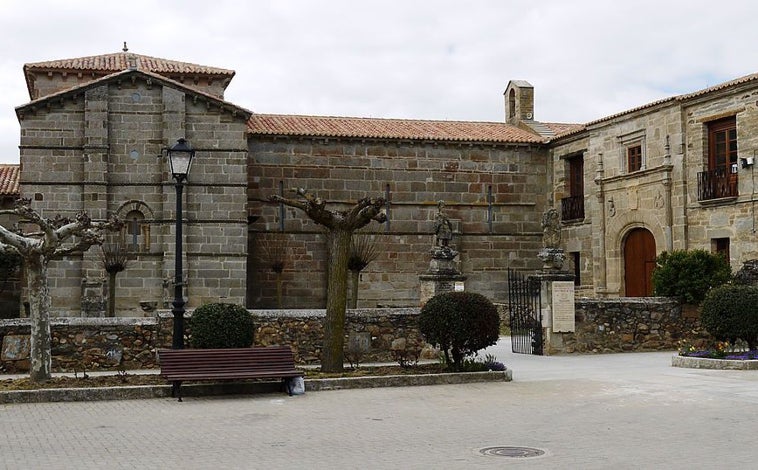This is the miracle that lights up Santa Marta de Tera in Zamora every September 20th.

In the north of the province of Zamora , in the Sierra de la Culebra, in the region of Benavente and the Valleys, in the center of the Tera Valley, at the foot of the Sanabrés-Mozarabic Way of St. James, an alternative branch to the Vía de la Plata, the traveler will find the church of Santa Marta de Tera , one of the first and most important monasteries along with Santa María de Moreruela and San Salvador de Tábara during the medieval repopulation. A jewel of the cultural heritage of our country that every September 20, at 10:00 am, becomes the scene of a unique prodigy that brings together hundreds of people to experience and contemplate the phenomenon of the equinoctial light , known as the Zamora 'miracle of light'.
Built on a Roman villa and a Visigoth sanctuary, Santa Marta de Tera has been referenced since the 10th century during the conquest of the territories from the Muslims. It is Romanesque in style and was built with sandstone and slate blocks. It has a Latin cross plan, a single nave divided into three sections, a dome, a transept, a quadrangular chancel, and three doorways.
Its name comes from the relics of the Astorga native and martyr Saint Martha, which arrived during the time of King Ferdinand I and Queen Sanch . Originally a monastery, now a church, it always enjoyed the favour of the Leonese nobility and monarchy, receiving large donations. The Infanta Elvira, daughter of Alfonso VI, and Ferdinand I himself, and even Alfonso VII, made pilgrimages there to give thanks to the holy martyr for the supposed cure of a serious illness.
Centuries later, after being exiled, it passed into the domain of the Bishopric of Astorga, which decided to build a summer palace next to the sanctuary. Today, the palace houses the coat of arms of Bishop Pedro Acuña, who built the palace, and medallions with the effigies of Charles I and Pope Julius III. A temple, now declared a National Monument and Site of Cultural Interest , which preserves unique details for the attentive and curious visitor.
There are numerous Roman and Visigothic ashlars reused in its walls, which bear more than forty different stonemason's marks, some visible and others hidden. These walls also bear the so-called " Jaqués checkerboard ," the stonemason's mark that indicated to pilgrims that they could seek shelter here. Singularities are also found in the north portico, through which one enters, where we are greeted by a large petra statue of Saint Jude Thaddeus , as the inscription on it reads.
In the south portico, there are two sculptures, one of Saint John and the other of Saint James, the latter a treasure that once graced commemorative stamps. The sculpture depicts the 'son of thunder' wearing a staff, a bag, and a scallop shell. This is the oldest sculptural representation of the pilgrim apostle, not only in Spain but in Europe.



The surprises continue on the cornices. A bestiary of fantastical animals, including sirens, dragons, griffins, and human harpies, is carved into them. And inside, where a special energy permeates, we find beautiful and delicate capitals that tell stories, such as that of David and Saul playing with musicians, the sacrifice of Isaac, the battle of David and Goliath, the Adulterous Woman, or that of the Three Faces, who gaze at us hieratic and inquisitive from on high.
But among all the details, one stands out, located on a column on the left side of the apse. It is the ' Capitel del Alma ' or 'Capitel of the Just Soul'. Carved in limestone is an asexual, armless figure inside a mandorla, seemingly ascending to heaven accompanied by two angels. A capital that, as parish priest Julián Acedo discovered almost three decades ago after years of observation, is the protagonist of the extraordinary phenomenon: the equinoctial light of Santa Marta de Tera.
Unknown to many and forgotten by others, Zamora's 'miracle of light' occurs every September 20th , the autumn equinox, at 10:00 a.m. , when the first rays of dawn enter through the oculus located at the top of the apse. Amidst the silence and darkness, they shed light and begin to ascend the column until they completely illuminate the 'Capital of the Soul' for five minutes.
This is a prodigy created by medieval stonemasons —inherited from cultures such as Egypt, Greece, and Rome—linked to pagan solar cults that have existed since the church's construction. It would have had different earthly interpretations—linked to the holy martyr—and spiritual ones—related to the symbolic journey of the soul. But all of them are linked to the time of year when day and night are of equal length.
The equinoxes have always marked the astronomical calendar for humankind since ancient times, and they continue to do so in the 21st century. So, if you have the opportunity, dear reader, head to Zamora. Celes, the guardian of the church of Santa Marta de Tera , will open the doors at 9:30 a.m., fill the sanctuary with incense, and have everything ready for a unique and magical moment that fascinates and excites. The celebration concludes with a concert and hot chocolate to celebrate the end of summer and the beginning of autumn.
ABC.es




